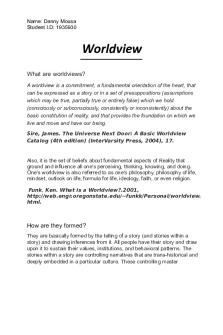5ks in Sikhism final unit assignment what the 5 k are and what they mean PDF

| Title | 5ks in Sikhism final unit assignment what the 5 k are and what they mean |
|---|---|
| Author | Mehak Sharma |
| Course | Introduction to World Religions |
| Institution | Lakehead University |
| Pages | 4 |
| File Size | 69.1 KB |
| File Type | |
| Total Downloads | 57 |
| Total Views | 153 |
Summary
Sikhism assignment about the 5 K and what the mean and what they are . this is a concise essay assignment which is worth 15% of my final mark...
Description
5ks in Sikhism
Mehak Sharma Lakehead University South Asian Religions Dr. Brian Philip Dun December 3, 2021
5ks in Sikhism The 5ks dates way back from the establishment of Khalsa Panth by Guru Gobind Singh, in 1699. The main aim of the symbols was to identify the Khalsa members, and they also represented their unity. It also reminds people that every Sikh saint, warrior, or martyr and every living individual of the Khalsa is connected with them through the 5ks. The identity of Sikh indicates the alignment of the people's lives with the truth of Ek Onkar, who was the One and true God (Gateway to Sikhism, 2021). They further remind Sikh people of the spiritual and ethical implications of the fact. Their meaning and symbols are as discussed below. Kesh was the uncut hair that represents disciplined holiness. According to the Sikh people, hair was part of God's creation, and maintaining it and not cutting it indicated that people were willing to accept the gift from God as it was intended. Uncut hair depicted the denial of pride in people's appearance and living a simple life. It meant that people would go beyond the spiritual body and acquire spiritual maturity. Kangha was the comb representing the cleanliness, honor, and care given to the hair. It was kept clean and tied into a topknot. It was also a symbol of dignity by contrast to the dreadlocked Hindu sadhus and sannyasis. Kanga symbolizes the benefits of taking care of the body created by God (Gateway to Sikhism, 2021). Sikh people wore the kangha which represented hygiene and that people were ridding their impurities and what was considered morally undesirable. It enforced the perception that people would maintain body, mind, and spiritual cleanliness. The comb was made of wood as it was meant to reduce the static energy levels developed when combing the hair. Kaccha were cotton undergarments that were described as britches. They represented sexual restraint among the people who wore them. The garment never went under the knee and
was mainly worn during warfare when riding horses. It was a symbol of purity. It enhanced the freedom of movement throughout and briskness during the action. Kara was a circular steel bangle that reminded people of the infinity and oneness of Ek Omkar. The circular shape signifies God's togetherness, oneness, and eternity, who was perfect. It also reminded people to use their hands for practical reasons. The steel bracelet reminded the Sikh people that they should not do things the Guru disapproves of. It also portrayed a God with no beginning or end and a permanent connection to the community. It was primarily worn in the right hand as many people performed their tasks, thus doing good deeds. Wearing it on the wrist indicated that the wearer should never extend their other hand to do evil. It was made of steel and not gold or silver because it was not an ornament. Kirpan was a sword or dagger that was symbolically worn and represented the ethics of maintaining justice and protecting the weak. The ceremonial sword was around three feet long and was kept in a sheath or worn under or under clothing. In most cases, it was worn very close to the body's skin under the clothes or strapped around the torso and shoulder when attached by a fabric holster. It also symbolized spirituality, struggle against injustice, and a metaphor of God.
References Gateway to Sikhism. (2021). The Sikh Identity:5Ks. https://www.allaboutsikhs.com/introduction/the-sikh-identity-5ks/...
Similar Free PDFs

E What do they mean by that
- 5 Pages

What does the concept of CSR mean?
- 10 Pages

What Are Other payables
- 1 Pages

What are transition metals
- 14 Pages

What are worldviews
- 3 Pages

What are conf inter
- 8 Pages
Popular Institutions
- Tinajero National High School - Annex
- Politeknik Caltex Riau
- Yokohama City University
- SGT University
- University of Al-Qadisiyah
- Divine Word College of Vigan
- Techniek College Rotterdam
- Universidade de Santiago
- Universiti Teknologi MARA Cawangan Johor Kampus Pasir Gudang
- Poltekkes Kemenkes Yogyakarta
- Baguio City National High School
- Colegio san marcos
- preparatoria uno
- Centro de Bachillerato Tecnológico Industrial y de Servicios No. 107
- Dalian Maritime University
- Quang Trung Secondary School
- Colegio Tecnológico en Informática
- Corporación Regional de Educación Superior
- Grupo CEDVA
- Dar Al Uloom University
- Centro de Estudios Preuniversitarios de la Universidad Nacional de Ingeniería
- 上智大学
- Aakash International School, Nuna Majara
- San Felipe Neri Catholic School
- Kang Chiao International School - New Taipei City
- Misamis Occidental National High School
- Institución Educativa Escuela Normal Juan Ladrilleros
- Kolehiyo ng Pantukan
- Batanes State College
- Instituto Continental
- Sekolah Menengah Kejuruan Kesehatan Kaltara (Tarakan)
- Colegio de La Inmaculada Concepcion - Cebu









